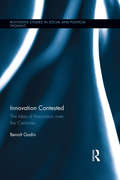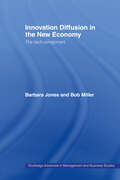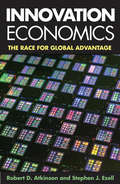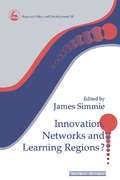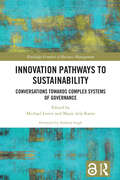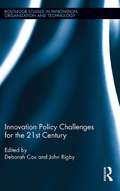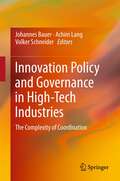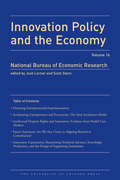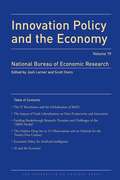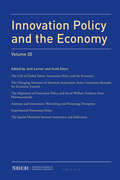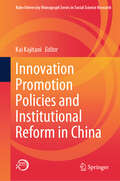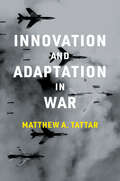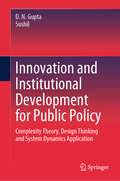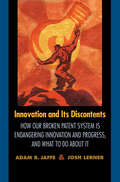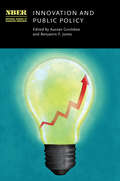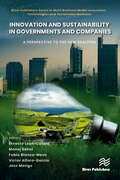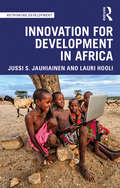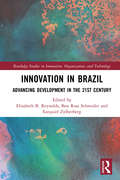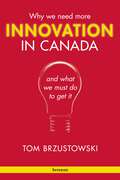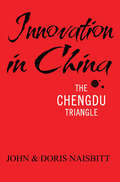- Table View
- List View
Innovation Contested: The Idea of Innovation Over the Centuries (Routledge Studies in Social and Political Thought)
by Benoît GodinInnovation is everywhere. In the world of goods (technology), but also in the world of words: innovation is discussed in the scientific and technical literature, but also in the social sciences and humanities. Innovation is also a central idea in the popular imaginary, in the media and in public policy. Innovation has become the emblem of the modern society and a panacea for resolving many problems. Today, innovation is spontaneously understood as technological innovation because of its contribution to economic "progress". Yet for 2,500 years, innovation had nothing to do with economics in a positive sense. Innovation was pejorative and political. It was a contested idea in philosophy, religion, politics and social affairs. Innovation only got de-contested in the last century. This occurred gradually beginning after the French revolution. Innovation shifted from a vice to a virtue. Innovation became an instrument for achieving political and social goals. In this book, Benoît Godin lucidly examines the representations and meaning(s) of innovation over time, its diverse uses, and the contexts in which the concept emerged and changed. This history is organized around three periods or episteme: the prohibition episteme, the instrument episteme, and the value episteme.
Innovation Diffusion in the New Economy: The Tacit Component (Routledge Advances In Management And Business Studies)
by Barbara Jones Bob MillerThis book unites discussions of the philosophical and scientific basis of tacit knowledge.The authors give an overview of the theories of tacit knowledge and explain how these relate to a background of philosophical, neurological and pedagogic literature. The importance of tacit knowledge for evolutionary models of innovation is analyzed raising qu
Innovation Economics
by Robert D. AtkinsonThis important book delivers a critical wake-up call: a fierce global race for innovation advantage is under way, and while other nations are making support for technology and innovation a central tenet of their economic strategies and policies, America lacks a robust innovation policy. What does this portend? Robert Atkinson and Stephen Ezell, widely respected economic thinkers, report on profound new forces that are shaping the global economy—forces that favor nations with innovation-based economies and innovation policies. Unless the United States enacts public policies to reflect this reality, Americans face the relatively lower standards of living associated with a noncompetitive national economy. The authors explore how a weak innovation economy not only contributed to the Great Recession but is delaying America's recovery from it and how innovation in the United States compares with that in other developed and developing nations. Atkinson and Ezell then lay out a detailed, pragmatic road map for America to regain its global innovation advantage by 2020, as well as maximize the global supply of innovation and promote sustainable globalization.
Innovation Law and Policy in the European Union: Towards Horizon 2020
by Massimiliano Granieri Andrea RendaThe book provides a critical overview of innovation policy in Europe and a synopsis of the current institutional framework of Europe shaped after the Europe2020 strategy and in view of the upcoming Horizon2020 agenda. What emerges is a rather gloomy outlook for the future of Europe's innovation, unless EU institutions and Member States will decide to streamline existing policies and build a "layered" model of innovation, in which governments act as investors in key enabling infrastructure such as ICT and education; as enablers of large technology markets where researchers and entrepreneurs can meet; and as purchasers of innovation when key societal challenges are at stake. The book contains proposals for the future innovation strategy of the EU and a specific analysis of areas such as the unitary patent, the transfer of technology (particularly as far as climate-related technologies and IP markets are concerned), standardization, and the digital agenda.
Innovation Networks and Learning Regions? (Regions and Cities #No. 18)
by James SimmeInnovation, Networks and Learning Regions? address key issues of understanding in contemporary economic geography and local economic policy making in cities and regions in the advanced economies. Developing the idea that innovation is the primary driving force behind economic change and growth, the international range of contributors stress the importance of knowledge and information as the 'raw materials' of innovation. They examine the ways in which these elements may be acquired and linked through networks, and demonstrate that there are empirical examples of innovative areas which do not have highly developed networks yet appear to be relatively successful in terms of local economic growth. In so doing, they raise crucial questions about the ways in which regions or localities might be described as truly 'learning' areas, and about the sustainability of future economic and quality of life success based on innovation and high-technology.
Innovation Pathways to Sustainability: Conversations Towards Complex Systems of Governance (Routledge Frontiers of Business Management)
by Michael Lester Marie Dela RamaThe book offers insights into reconciling innovation with sustainability and identifying key stakeholders responsible for the reconciliation. Through conversations with experts in various fields, the intersection of innovation, sustainability, governance and complex systems in a rapidly changing climate-driven world is discussed.Countries around the world face the urgent existential challenge to tackle climate change and CO2 emissions. In its discussions of case studies of key economic sectors in Australia, this book focuses on the emerging experience with harnessing innovation to sustainability. The interdisciplinary approach to the complexity of climate change and policy making provides readers an opportunity for thoughtful discussions and lessons to be learnt from multiple angles.This is a vital resource for scholars in climate studies, innovation and sustainability that also confronts important challenges facing policymakers, government and society.
Innovation Policy Challenges for the 21st Century (Routledge Studies in Innovation, Organizations and Technology)
by Deborah Cox John RigbyAs the economies of western countries move from primarily resource-based to knowledge-based, and trade liberalization limits what governments can do through direct action, the landscape of innovation is changing and policymakers must react accordingly. This exciting new book examines the challenges that policy makers face in responding to a new environment. The book addresses how governments are now seeking to drive innovation through new forms of R&D policies, through public procurement, skills development, entrepreneurship and innovation culture to name but a few of the approaches. Innovation Policy Challenges for the 21st Century explores these and other contemporary issues in innovation, reviewing the state of the art literature and consolidating current thinking at the frontiers of innovation. The volume debates and presents scattered and anonymous material in a coherent way, with a particular focus is on ‘hot topics’ in the field of innovation studies that have been previously under-researched. The book is divided into four key themes: government as a key actor in the innovation process, entrepreneurs as innovators, skills and competences required to maintain and improve innovation performance in Europe and finally, the wider context in which innovation policy develops.
Innovation Policy and Governance in High-Tech Industries: The Complexity of Coordination
by Johannes Bauer Achim Lang Volker SchneiderThe book examines the conditions for successful high-technology policy from theoretical and empirical perspectives. It enhances the predominant national systems of innovation approach to innovation policy with concepts based on new developments in the governance of complex systems and processes. The conceptual framework of complex networks and systems is used to examine national policy approaches in countries that have created environments conducive to high-technology industries as well as individual high-technology sectors, such as biotechnology, alternative energy, and aerospace. Theoretical and empirical contributions are synthesised into lessons for high-tech policy and further research.
Innovation Policy and the Economy 2015: Volume 16 (National Bureau of Economic Research Innovation Policy and the Economy)
by The University of Chicago PressThe papers in the sixteenth volume of the National Bureau of Economic Research’s Innovation Policy and the Economy offer insights into the changing landscape of innovation by highlighting recent developments in the financing of innovation and entrepreneurship and in the economics of innovation and intellectual property. The first chapter, by Ramana Nanda and Matthew Rhodes-Kropf, explores the process of experimentation in the context of financing of technology start-ups by venture capitalists. The second, by Yael Hochberg, also analyzes the role of entrepreneurial experimentation by systematically examining the rise of start-up accelerators. The third chapter, by Heidi Williams, studies the relationship between the strength of intellectual property rights and innovation. The fourth paper, by Fiona Scott Morton and Carl Shapiro discusses recent changes to the patent system and whether they align the rewards from intellectual property with the marginal contributions made by innovators and other stakeholders. The final chapter, by Karim Lakhani and Kevin Boudreau, focuses on the potential use of field innovation experiments and contests to inform innovation policy and management. Together, these essays continue to highlight the importance of economic theory and empirical analysis in innovation policy research.
Innovation Policy and the Economy, 2018: Volume 19 (National Bureau of Economic Research Innovation Policy and the Economy #19)
by The University of Chicago PressThis volume highlights the interaction between public policy and innovation. The first chapter documents the dramatic globalization of R&D and how this development has affected the efforts of U.S. multinationals to operate on the global technology frontier. The next chapter synthesizes research on the impact of trade shocks on innovation and explains how these shocks’ effects depend on the firms, industries, and countries affected. The third chapter examines the Advanced Research Projects Agency (ARPA) model of research management—an approach to funding and managing high-risk R&D—and offers a method for diagnosing which research efforts are “ARPA-able.” Next is a study of the Orphan Drug Act and the key changes in the U.S. healthcare landscape and in drug discovery and development since its passage in 1983. The next two chapters focus on artificial intelligence (AI). One describes how AI diffuses through the economy and discusses implications for economic inequality, antitrust, and intellectual property. The other investigates issues surrounding firm competition and labor force participation, such as data portability and a Universal Basic Income, and evaluates ways to address these issues.
Innovation Policy and the Economy, 2019: Volume 20 (National Bureau of Economic Research Innovation Policy and the Economy)
by The University of Chicago PressThe chapters in this twentieth volume of Innovation Policy and the Economy present research on the interactions among public policy, the innovation process, and the economy. One explores changes in the ability of the U.S. to attract talented foreign workers and the role of sponsoring institutions in shaping immigration policy. Another explains how the division of innovative labor between research universities and corporate labs affected productivity growth and the transformation of knowledge into new products and processes. A third reviews different innovation policies and their performance in the pharmaceutical sector. Next is a chapter on the effects of competition policy on innovation, “creative destruction,” and economic growth. A fifth chapter studies how experimental policy design can be a cost-effective way to attain program goals. The last chapter examines geographic disparities in innovation, joblessness, and technological dynamism and studies how reallocation of grants and geographically targeted entrepreneurship policy could affect labor supply and welfare.
Innovation Promotion Policies and Institutional Reform in China (Kobe University Monograph Series in Social Science Research)
by Kai KajitaniThis book focuses on the political economy behind innovation in China's new industrial sectors, particularly the effects of policies and government regulation in the absence of the rule of law. In its analysis, the book aims to elucidate the mechanisms that generate innovation from multiple perspectives while utilizing insights from political science and law. The analysis in this book focuses on the following three points. First, by examining Guizhou Province's Big-data industry promotion policy, "import substitution digitization" policy, and government intellectual property strategy, we seek to empirically clarify the extent to which Chinese government industrial policy has stimulated innovation. Next, we examine in detail the issues surrounding the "rule of law" in China regarding introducing anti-monopoly laws for digital platform companies and developing the intellectual property court system. Third, it focuses on the role played by local governments in industrial policy, including the impact of industrial guidance funds on the efficiency of the regional financial sector and the impact of local bond issuance on the effectiveness of resource allocation among regions.
Innovation and Accountability in Teacher Education: Setting Directions for New Cultures in Teacher Education (Teacher Education, Learning Innovation and Accountability)
by Claire Wyatt-Smith Lenore AdieThis is the foundational book for the new series, Teacher Education, Learning Innovation and Accountability. The book canvasses research, practice and policy perspectives in teacher education across diverse geographic, social and political contexts. It explores the lifespan of teacher development from initial preparation through to graduate classroom practice as it occurs in an intensifying culture of standards and regulation. The characterization of initial teacher education (ITE) in a crucible of change permeates throughout the book. The chapters open up new ways of thinking about innovation and accountability in ITE and the professionalization of teaching, exploring fundamental questions, such as “Who are the actors in teacher preparation and how do they interact? How can we learn about the quality of teacher education? Where can we hear the voices of teacher educators and preservice teachers, as well as school-based teacher educators? What are the new and emerging roles of others in teacher education who have not been involved previously, including employing authorities?” (p. 22). While the book provides responses to these and other provocative questions, it also offers new insights into innovative teacher education from a wide range of policy and practice contexts.
Innovation and Adaptation in War (Belfer Center Studies in International Security)
by Matthew A. TattarAn analysis of advances in military technology that illustrates the importance of organizational flexibility in both an attacker&’s innovations and an opponent&’s adaptations.How important is military innovation in determining outcomes during armed conflict? In Innovation and Adaptation in War, Matthew Tattar questions the conventional wisdom that, to succeed, military organizations must innovate early and often. Because successful methods of warfare are soon widely imitated or countered on the international stage, the advantages of a particular innovation quickly evaporate. Therefore, Tattar argues, large-scale innovations at the cost of organizational flexibility and the ability to adapt to an adversary&’s innovations may not be the optimal path—not just because force readiness is vital but also because innovation does not provide as long-lasting and decisive an advantage as may have been previously thought.Although other scholars have analyzed the sources of military innovation, Tattar is the first to focus on the relationship between innovation and specific military outcomes. Looking at several different types of military organizations and many different types of battles, he draws on theoretical works, in-depth historical research, and case studies, and finds that the initial advantages that are generated by innovation disappear far too rapidly in wartime for militaries to depend on them for victory. Furthermore, as Tattar demonstrates, emphasizing innovation in defense planning at the expense of organizational flexibility can have significant negative consequences. The decisive factor in successful adaptation, more often than not, is a well-positioned and flexible organization. Providing both a new framework for studying military innovation and a comprehensive review of the current literature in this field, Innovation and Adaptation in War offers crucial policymaking insights into when and under what circumstances militaries should innovate and adapt.
Innovation and Inequality
by Gilles Saint-PaulKarl Marx predicted a world in which technical innovation would increasingly devalue and impoverish workers, but other economists thought the opposite, that it would lead to increased wages and living standards--and the economists were right. Yet in the last three decades, the market economy has been jeopardized by a worrying phenomenon: a rise in wage inequality that has left a substantial portion of the workforce worse off despite the continuing productivity growth enjoyed by the economy. Innovation and Inequality examines why. Studies have firmly established a link between this worrying trend and technical change, in particular the rise of new information technologies. In Innovation and Inequality, Gilles Saint-Paul provides a synthetic theoretical analysis of the most important mechanisms by which technical progress and innovation affect the distribution of income. He discusses the conditions under which skill-biased technical change may reduce the wages of the least skilled, and how improvements in information technology allow "superstars" to increase the scale of their activity at the expense of less talented workers. He shows how the structure of demand changes as the economy becomes wealthier, in ways that may potentially harm the poorest segments of the workforce and economy. An essential text for graduate students and an indispensable resource for researchers, Innovation and Inequality reveals how different categories of workers gain or lose from innovation, and how that gain or loss crucially depends on the nature of the innovation.
Innovation and Institutional Development for Public Policy: Complexity Theory, Design Thinking and System Dynamics Application
by Sushil D. N. GuptaThis book offers a comprehensive perspective on policy theories, policy formulation and implementation, and alternative paradigm for dealing with complex social and economic systems. It presents insights into policies on major development sectors, including health, education, urbanization, climate change, innovation, advanced manufacturing, and economic growth. It delves into why public policies matter more than resources and are crucial for shaping the future of a country. It attempts a pioneering effort and delineates a complexity theory framework to deal with uncertainty, nonlinearity, emergence, and evolution. It comprises systems thinking, design thinking, complexity thinking, and tools for complexity analysis. Applicable to a policy system, economy, business, and organization, the complexity theory relies on phenomena like emergence, self-organizing property, adaptation, coevolution, and path dependency, in a clear departure from reductionism and Newtonian paradigm. Through academic rigor, it makes a convincing case for better understanding of application of complexity theory. It covers real-world examples and case studies related to evolution of economies of silicon valleys – Bengaluru (India) and San Francisco Bay (USA). These cases underscore the essentiality of complexity theory. In terms of policy formulations, the book contains a policy design framework covering the science of policymaking, innovative approaches, and methodology for policy design. To deal with dynamic systems, it includes a step-by-step guide for the application of system dynamics. It articulates alternative paradigm – adaptive policies and policy design; alternative theory – complexity theory; and new public organizations and institutional development for meeting the challenges of the 21st century. Aiming to reduce fuzziness, the book combines both researcher’s in-depth analysis as well as practitioner’s perspective, thus serving as a vital read for scholars of public policy, management, and economics. It emphasizes the primacy of policy process to discern deep understanding from the ground and to integrate micro-level realities and macro-level requirements. It argues for change from Weberian bureaucratic model to adaptive approaches and recommends policy system reforms, highlighting that countries should make the right policy choices early to steer ahead. In doing so, the book serves the requirements of policymakers and thought leaders.
Innovation and Its Discontents: How Our Broken Patent System is Endangering Innovation and Progress, and What to Do About It
by Josh Lerner Adam B. JaffeThe United States patent system has become sand rather than lubricant in the wheels of American progress. Such is the premise behind this provocative and timely book by two of the nation's leading experts on patents and economic innovation. Innovation and Its Discontents tells the story of how recent changes in patenting--an institutional process that was created to nurture innovation--have wreaked havoc on innovators, businesses, and economic productivity. Jaffe and Lerner, who have spent the past two decades studying the patent system, show how legal changes initiated in the 1980s converted the system from a stimulator of innovation to a creator of litigation and uncertainty that threatens the innovation process itself. In one telling vignette, Jaffe and Lerner cite a patent litigation campaign brought by a a semi-conductor chip designer that claims control of an entire category of computer memory chips. The firm's claims are based on a modest 15-year old invention, whose scope and influenced were broadened by secretly manipulating an industry-wide cooperative standard-setting body. Such cases are largely the result of two changes in the patent climate, Jaffe and Lerner contend. First, new laws have made it easier for businesses and inventors to secure patents on products of all kinds, and second, the laws have tilted the table to favor patent holders, no matter how tenuous their claims. After analyzing the economic incentives created by the current policies, Jaffe and Lerner suggest a three-pronged solution for restoring the patent system: create incentives to motivate parties who have information about the novelty of a patent; provide multiple levels of patent review; and replace juries with judges and special masters to preside over certain aspects of infringement cases. Well-argued and engagingly written, Innovation and Its Discontents offers a fresh approach for enhancing both the nation's creativity and its economic growth.
Innovation and Public Policy (National Bureau of Economic Research Conference Report)
by Austan Goolsbee Benjamin F. JonesUsing the latest empirical and conceptual research for readers in economics, business, and policy, this volume surveys the key components of innovation policy and the social returns to innovation investment. In advanced economies like the United States, innovation has long been recognized as a central force for increasing economic prosperity and human welfare. Today, the US government promotes innovation through various mechanisms, including tax credits for private-sector research, grant support for basic and applied research, and institutions like the Small Business Innovation Research Program of the National Science Foundation. Drawing on the latest empirical and conceptual research, Innovation and Public Policy surveys the key components of innovation policy and the social returns to innovation investment. It examines mechanisms that can advance the pace of invention and innovative activity, including expanding the research workforce through schooling and immigration policy and funding basic research. It also considers scientific grant systems for funding basic research, including those at institutions like the National Institutes of Health and the National Science Foundation, and investigates the role of entrepreneurship policy and of other institutions that promote an environment conducive to scientific breakthroughs.
Innovation and Public Policy (National Bureau of Economic Research Conference Report)
by Austan Goolsbee Benjamin F. JonesUsing the latest empirical and conceptual research for readers in economics, business, and policy, this volume surveys the key components of innovation policy and the social returns to innovation investment. In advanced economies like the United States, innovation has long been recognized as a central force for increasing economic prosperity and human welfare. Today, the US government promotes innovation through various mechanisms, including tax credits for private-sector research, grant support for basic and applied research, and institutions like the Small Business Innovation Research Program of the National Science Foundation. Drawing on the latest empirical and conceptual research, Innovation and Public Policy surveys the key components of innovation policy and the social returns to innovation investment. It examines mechanisms that can advance the pace of invention and innovative activity, including expanding the research workforce through schooling and immigration policy and funding basic research. It also considers scientific grant systems for funding basic research, including those at institutions like the National Institutes of Health and the National Science Foundation, and investigates the role of entrepreneurship policy and of other institutions that promote an environment conducive to scientific breakthroughs.
Innovation and Sustainability in Governments and Companies: A Perspective to the New Realities (River Publishers Series in Multi Business Model Innovation, Technologies and Sustainable Business)
by Fabio Blanco-Mesa Manoj Sahni Ernesto Leon-Castro Victor Alfaro-Garcia Jose MerigoInnovation and sustainability are issues that have become very relevant in recent years. This book presents a compilation of investigations on these topics, divided into those applied in government or enterprises. The objective is to demonstrate to the audience how these issues have been worked around the world and in different scenarios. Among the papers, there are works related to economic variables, imports, exports, and analysis in different sectors such as tourism, agriculture, education, and even in countries in general.
Innovation and Teaching Technologies
by Marta Peris-Ortiz Fernando J. Garrigós-Simón Ignacio Gil PechuánThis book focus on organizational changes that are taking place in higher education Universities are currently experiencing a period of change and restructuring into what is known as the European Higher Education Area (EHEA). EHEA represents a process of educational reform based on three types of transformations: structural, curricular and organizational. The integration of universities in this new EHEA is bringing conceptual and methodological changes not just to the structure of university education, but also to the teaching-learning processes and the conditions under which they take place. EHEA is prompting a change in the teaching model towards the consideration of students as the main actors in the educational process. This change requires new teaching strategies where students are asked to resolve problems with tools provided by the teacher This book presents ideas, results and challenges related to new information and communication technologies, innovations and methodologies applied to education and research, as well as demonstrating the latest trends in educational innovation.
Innovation for Development in Africa (Rethinking Development)
by Jussi S. Jauhiainen Lauri HooliThis book uncovers the many ways in which innovations and innovation system development policies have become crucial to development policy formation across Africa. As new instruments, actors and tools emerge in development cooperation, the role of innovation in the societal development of developing countries needs to be addressed fully. This book delves into subjects as diverse as the changing development policies between the Global North and South, the role of innovation in international aid and development policies, the role of public, private and non-governmental sectors, universities and other development actors, and the potential for inclusive innovation in local communities. In particular, the book asks who benefits from innovation-focussed development policies, and if and how practical innovation instruments include the global poor. Written in an accessible and engaging style, the book includes a range of discussion questions and further reading suggestions to suit a range of readers, from students right through to policy makers and practitioners, or anyone else looking for an introduction to innovation policies and development in Africa.
Innovation in Brazil: Advancing Development in the 21st Century (Routledge Studies in Innovation, Organizations and Technology)
by Ben Ross Schneider Elisabeth B. Reynolds Ezequiel ZylberbergSince the early 2000s, state-led and innovation-focused strategies have characterized the approach to development pursued in countries around the world, such as China, India, and South Korea. Brazil, the largest and most industrialized economy in Latin America, demonstrates both the opportunities and challenges of this approach. Over the course of nearly 20 years, the Brazilian government enacted various policies and programs designed to strengthen the country’s capacity to innovate. It increased spending on science and technology, encouraged greater collaboration between industry and universities, and fostered the creation of new institutions whose primary aim was to facilitate greater private research and development (R&D) spending. In this book, the editors unite a diverse array of empirical contributions around a few key themes, including public policies, institutions and innovation ecosystems, and firms and industries, that collectively make the case for a new, forward-looking innovation agenda aimed at addressing persistent challenges and exploiting emerging opportunities in Brazil. Its conclusions offer valuable lessons for other developing and emerging economies seeking to accelerate innovation and growth in the modern age. With its interdisciplinary and wide-ranging contribution to the study of innovation, as well as attention to broader policy implications, this book will appeal to scholars and professionals alike.
Innovation in Canada: Why We Need More and What We Must Do to Get It
by Thomas BrzustowskiCanada has a prosperity problem because we don t create enough wealth. Business as usual is not a solution; we need to create more value in new ways - that s innovation. But beyond innovation to solve our current problems, we must learn how to innovate in new ways to deal with whatever future pressures and opportunities arise from global demographics and climate change. Innovation in Canada demystifies innovation and presents its many aspects in one big picture. The book proposes innovation in both goods and services as the means for increasing the value of what the Canadian economy produces. This will raise our prosperity and show up as improved productivity. Written in plain language and illustrated with corporate data, the book underlines the essential roles of technology, entrepreneurship and commerce. It points out important differences between innovation in established firms and innovation in new ventures, whose time scales are shorter and whose needs are more urgent. Innovation in Canada proposes the elements of a supportive government innovation policy, and it outlines the different design principles for government assistance programs needed to provide effective support to the two different groups of innovative companies.
Innovation in China
by John And NaisbittChengdu - a model for China's Innovation pathHow could Chengdu, in less than a decade, transform from an underdeveloped inland city to become the leader in urban rural integration, home to ultra modern high tech parks and host to more than 200 of Fortune 500 companies? Two years of the authors' research have resulted in the theory of the Chengdu Triangle: property rights reform, equalization of public service, grassroots democracy, and in the core, respect for individual rights. A holistic, service oriented and innovative spirit enabled Chengdu's government to simultaneously work on social, economic and legal change. Efforts in each one of them supporting and accelerating progress in all of them.In the view of the authors, the approach of the Chengdu Triangle can not only be taken as a model for Chinese cities, but for cities in all parts of the world which have to deal with a widening gap between rich and poor and urban and rural. Innovative thinking cannot be limited to technological and business theories, but must be expanded to walking new paths in abolishing social inequity and injustice.
